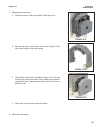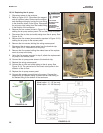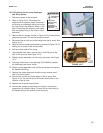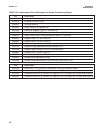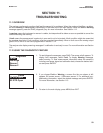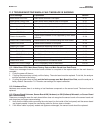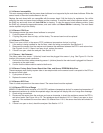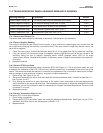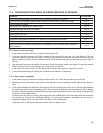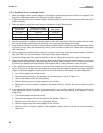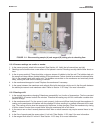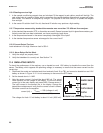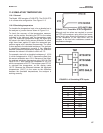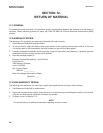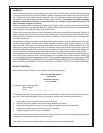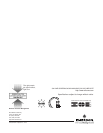
63
MODEL TCL SECTION 11
TROUBLESHOOTING
11.5 TROUBLESHOOTING WHEN NO ERROR MESSAGE IS SHOWING
15.5.1 Zero current is too high
1. Is the sensor properly wired to the analyzer? See Section 4.3.
2. Is the zero solution chlorine free? Take a sample of the zero solution and test it for total chlorine. The con-
centration should be less than 0.05 ppm. Avoid using tap water for zeroing the sensor. Even though the tap
water contains no iodine, chlorine oxidants present in the tap water may produce a sensor current as high as
100 nA.
3. Has adequate time been allowed for the sensor to reach a minimum stable zero current? It may take several
hours, sometimes as long as overnight, for a new sensor to stabilize.
4. Is the sensor fill solution fresh? An old, discolored fill solution may produce a high zero current.
5. Is the membrane damaged? Inspect the membrane and replace it if necessary.
11.5.2 Zero current is unstable
1. Is the sensor properly wired to the analyzer? See Section 4.3. Verify that all connections are tight.
2. Readings can be erratic when a new sensor is first placed in service. Readings usually stabilize over about an
hour.
3. Is the space between the membrane and cathode filled with electrolyte solution and is the flow path between
the electrolyte reservoir and membrane clear? Often the flow of electrolyte can be started by simply holding
the sensor with the membrane end pointing down and sharply shaking the sensor a few times as though shak-
ing down a clinical thermometer.
If shaking does not work, try clearing the holes around the cathode stem. Hold the sensor with the membrane
end pointing up. Unscrew the membrane retainer and remove the membrane assembly. Use the end of a
straightened paper clip to clear the holes at the base of the cathode stem.
Verify the sensor is filled with electrolyte solution. Refer to Section 10.2.
Problem See Section
Zero current was accepted, but the current is outside the range -10 to 50 nA 11.5.1
Error or warning message appears while zeroing the sensor (zero current is too high) 11.5.1
Zero current is unstable 11.5.2
Sensor can be calibrated, but current is low 11.5.3
Process readings are erratic or wander 11.5.4
Readings drift 11.5.5
Readings are too high 11.5.6
Readings are too low 11.5.3
Calibration temperature more than 3°C different from standard thermometer 11.5.7
Current output is too low 11.5.8
Alarm relays do not operate when setpoint is exceeded or do not release when reading is
below setpoint
11.5.9



